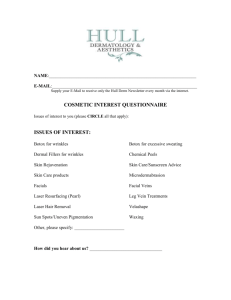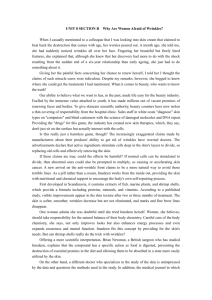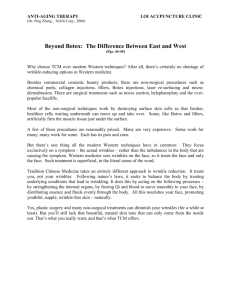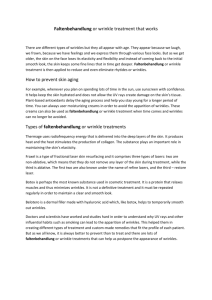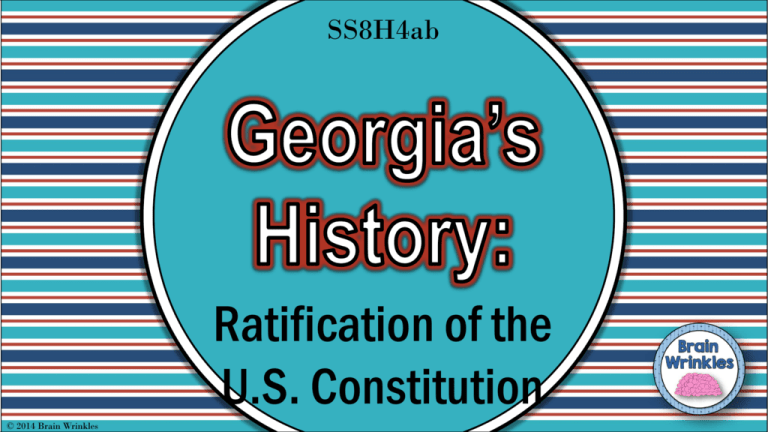
SS8H4ab
Ratification of the
U.S. Constitution
© 2014 Brain Wrinkles
Standards
SS8H4 The student will describe the impact of events that led to the
ratification of the United States Constitution and the Bill of Rights.
a. Analyze the strengths and weaknesses of both the Georgia Constitution of
of 1777 and the Articles of Confederation and explain how weaknesses in the
the Articles of Confederation led to a need to revise the Articles.
b. Describe the role of Georgia at the Constitutional Convention of 1787;
include the role of Abraham Baldwin and William Few, and reasons why
Georgia ratified the new constitution.
© 2014 Brain Wrinkles
Teacher Info – Who’s & What’s
• Print off the Who’s & What’s handout for each student. (Print front
and back to save paper.)
• BEFORE the lesson, have students fill in the squares with what they
think each term means.
• AFTER the presentation, the students will write down new (factual)
information about each term.
• Check the answers as a class.
© 2014 Brain Wrinkles
Who’s & What’s
Directions: BEFORE the lesson, write what you think each term means. AFTER the presentation,
you will write down new information about each term.
What I think this means:
Articles of Confederation
What I think this means:
Definition:
GA Constitution of 1777
Definition:
Who I think this is:
Abraham Baldwin
What I think this means:
Definition:
Constitutional Convention
Definition:
Who I think this is:
William Few
What I think this means:
Definition:
Great Compromise
Definition:
© 2014 Brain Wrinkles
Teacher Directions – CLOZE Notes
• The next pages are handouts for the students to use for note-taking
during the presentation. (Print front to back to save paper and ink.)
• Check the answers as a class after the presentation.
• *Please note – the slides in this presentation are content-heavy. Feel
free to open the editable file if you’d like to delete anything. I’ve found
that it’s better to have too much than not enough!
© 2014 Brain Wrinkles
Georgia Constitution
• In _________________________________________________________ was
implemented that defined separate executive, legislative, and judicial branches.
• The constitution also listed ________________________________ , outlined election
election process for governor (________________________________ ) and other
state officials, created a superior court for each county, and gave the state’s power to the
unicameral legislature.
• The Georgia Constitution of 1777 did a good job of
____________________________________________________ and protecting
basic rights of the citizens.
• However, it put too much power in the ________________________________ .
• Also, the legislature was __________________ so there was no check on its power.
• Georgia’s constitution was not ratified by a ________________________________ ,
so it did not fully represent their interests.
Articles of Confederation
• After the Revolutionary War ended, Congress began writing the
________________________________ with a strong central government in mind.
• Many states opposed this because they did ________________________________
and their goal was to give as much power as possible “to the people”.
• The Articles set up a ________________________________ where citizens elect
people to represent them.
• Unfortunately, the Articles created an
________________________________________________________ that gave
states a lot of power over their own affairs.
Weaknesses
• The Articles could ________________________________ to fund the government
(making it impossible to pay debts or soldiers).
• It could ________________________________ among the states (could put tariffs on
on each other).
• It provided for ________________________________________________ , only a
legislative branch.
• Congress could make laws, but _________________________________________
with them.
• Each state only ________________________________ , regardless of its population.
population.
• All 13 states had to ________________________________ for it to pass.
• Each state had its ________________________________ .
Time for Change
• The states
_____________________________________________________________ , and
Congress had no power to stop them.
• Foreign governments did not know if they were dealing with
_________________________________________________ different ones.
• The country’s _______________________________________________ .
© 2014 Brain Wrinkles
Convention
• The founders realized that the Articles of Confederation were
________________________________ to effectively govern the country and
________________________________ .
• In ________________________________ , delegates from all 13 states
________________________________ with the intent to change the Articles.
• The members ended up ________________________________ and writing a completely
completely new document.
• This meeting became known as the ________________________________ .
Abraham Baldwin
• Georgia had ________________________________ that signed the Constitution,
Abraham Baldwin and William Few.
• Abraham Baldwin was a native of Connecticut and a
______________________________________________________ .
• During the American Revolution, he served as a
_______________________________________________ .
• In 1784, he moved to Georgia and became a ________________________________ .
Representation
• During the Constitutional Convention, Baldwin was involved in debates over the
__________________________________________________ .
• With the Virginia Plan, small states were worried that they would be
__________________________________________________ .
• Baldwin changed his vote to side with the smaller states, and his
________________________________ .
Great Compromise
• To solve the representation issue, Baldwin helped develop the
________________________________ .
• This created a ________________________________ where each state had
_____________________________________________________ , but representation
in the House of Representatives was based on the ________________________________
________________________________ .
• The compromise pulled the convention out of a ________________________________ .
© 2014 Brain Wrinkles
Georgia Constitution
• In 1777, a new state constitution was implemented that defined separate executive,
executive, legislative, and judicial branches.
• The constitution also listed basic rights, outlined election process for governor
(one-year term) and other state officials, created a superior court for each county,
and gave the state’s power to the unicameral legislature.
• The Georgia Constitution of 1777 did a good job of separating the government
branches and protecting basic rights of the citizens.
• However, it put too much power in the hands of the legislature.
• Also, the legislature was unicameral so there was no check on its power.
• Georgia’s constitution was not ratified by a vote from its people, so it did not fully
fully represent their interests.
Articles of Confederation
• After the Revolutionary War ended, Congress began writing the Articles of
Confederation with a strong central government in mind.
• Many states opposed this because they did not want a monarchy and their goal was
was to give as much power as possible “to the people”.
• The Articles set up a republican democracy where citizens elect people to represent
represent them.
• Unfortunately, the Articles created an extremely weak central government that gave
gave states a lot of power over their own affairs.
Weaknesses
• The Articles could not levy taxes to fund the government (making it impossible to
to pay debts or soldiers).
It could not regulate trade among the states (could put tariffs on each other).
It provided for no judicial or executive branch, only a legislative branch.
Congress could make laws, but not force states to comply with them.
Each state only received 1 vote, regardless of its population.
All 13 states had to approve a law for it to pass.
Each state had its own currency.
•
•
•
•
•
•
Time for Change
• The states argued over borders and trade, and Congress had no power to stop them.
them.
• Foreign governments did not know if they were dealing with 1 country or 13
different ones.
• The country’s economy worsened.
© 2014 Brain Wrinkles
Convention
• The founders realized that the Articles of Confederation were too weak to
effectively govern the country and had to be revised.
• In May 1787, delegates from all 13 states met in Philadelphia with the intent to
change the Articles.
• The members ended up discarding the Articles and writing a completely new
document.
• This meeting became known as the Constitutional Convention.
Abraham Baldwin
• Georgia had two delegates that signed the Constitution, Abraham Baldwin and
William Few.
• Abraham Baldwin was a native of Connecticut and a graduate of Yale University.
© 2014 Brain Wrinkles
SS8H4a
and the
© 2014 Brain Wrinkles
•
Georgia’s provincial congress met after the Declaration of
Independence was adopted to create a new government.
•
In 1777, a new state constitution was implemented that defined
separate executive, legislative, and judicial branches.
•
The constitution also listed basic rights, outlined election
process for governor (one-year term) and other state officials,
created a superior court for each county, and gave the state’s
power to the unicameral legislature.
© 2014 Brain Wrinkles
•
The Georgia Constitution of 1777 did a good job of separating
the government branches and protecting basic rights of the
citizens.
•
However, it put too much power in the hands of the legislature.
•
Also, the legislature was unicameral so there was no check on
its power.
•
Georgia’s constitution was not ratified by a vote from its
people, so it did not fully represent their interests.
© 2014 Brain Wrinkles
• America’s first written constitution was not the
Constitution that we have in place today.
• After the Revolutionary War ended, Congress began
writing the Articles of Confederation with a strong
central government in mind.
• Many states opposed this because they did not want a
monarchy and their goal was to give as much power as
possible “to the people”.
© 2014 Brain Wrinkles
Drafting the Articles of
Confederation
© 2014 Brain Wrinkles
• The Articles of Confederation went into effect on March
1, 1781.
• The Articles set up a republican democracy where
citizens elect people to represent them.
• Unfortunately, the Articles created an extremely weak
central government that gave states a lot of power over
their own affairs.
© 2014 Brain Wrinkles
© 2014 Brain Wrinkles
• The Articles could not levy taxes to fund the
government (making it impossible to pay debts or
soldiers).
• It could not regulate trade among the states (could put
tariffs on each other).
• It provided for no judicial or executive branch, only a
legislative branch.
© 2014 Brain Wrinkles
• Congress could make laws, but not force states to
comply with them.
• Each state only received 1 vote, regardless of its
population.
• All 13 states had to approve a law for it to pass.
• Each state had its own currency.
© 2014 Brain Wrinkles
The United States did not have a
common currency under the Articles of
Confederation.
© 2014 Brain Wrinkles
• It soon became apparent that the Articles had to be
revised.
• The states argued over borders and trade, and Congress
had no power to stop them.
• Foreign governments did not know if they were dealing
with 1 country or 13 different ones.
• The country’s economy worsened.
© 2014 Brain Wrinkles
George Washington called the Articles of
Confederation “a half-starved, limping
government”.
© 2014 Brain Wrinkles
SS8H4b
Ratification of the
New Constitution
© 2014 Brain Wrinkles
• The founders realized that the Articles of Confederation were
too weak to effectively govern the country and had to be
revised.
• In May 1787, delegates from all 13 states met in Philadelphia
with the intent to change the Articles.
• The members ended up discarding the Articles and writing a
completely new document.
• This meeting became known as the Constitutional Convention.
© 2014 Brain Wrinkles
Independence Hall, Philadelphia
© 2014 Brain Wrinkles
Constitutional
Convention
1787
© 2014 Brain Wrinkles
• Georgia had two delegates that signed the Constitution,
Abraham Baldwin and William Few.
• Abraham Baldwin was a native of Connecticut and a graduate
of Yale University.
• During the American Revolution, he served as a chaplain in the
U.S. Army.
• In 1784, he moved to Georgia and became a successful
politician.
© 2014 Brain Wrinkles
Abraham Baldwin
© 2014 Brain Wrinkles
• During the Constitutional Convention, Baldwin was
involved in debates over the issue of representation.
• With the Virginia Plan, small states were worried that
they would be outnumbered by large states.
• Baldwin changed his vote to side with the smaller
states, and his vote forced a tie.
© 2014 Brain Wrinkles
• To solve the representation issue, Baldwin helped
develop the Great Compromise.
• This created a bicameral legislature where each state
had two members in the Senate, but representation in
the House of Representatives was based on the state’s
population.
• The compromise pulled the convention out of a
complete deadlock.
© 2014 Brain Wrinkles
© 2014 Brain Wrinkles
• In 1787, most Georgians supported a strong central
government.
• Georgia’s other delegate to the convention, William Few,
represented Georgians well by voting in favor of the
national government during critical times at the
convention.
• He worked diligently to make sure that the Constitution
was ratified.
© 2014 Brain Wrinkles
William Few
© 2014 Brain Wrinkles
Page 1 of the Original Copy of
the U.S. Constitution
© 2014 Brain Wrinkles
• On January 2, 1788, Georgia was the 4th state to ratify
the U.S. Constitution.
• Many Georgians favored a strong national government
that could protect them from Native Americans and the
Spanish in Florida.
• Georgians in coastal regions also hoped that the central
government would improve trade regulations.
© 2014 Brain Wrinkles
Teacher Directions – Georgia’s New Constitution
Poster
• Have the students create a poster to represent Georgia’s
Constitution of 1777.
• The students should include symbols that represent the
strengths and weaknesses of the constitution on the poster.
© 2014 Brain Wrinkles
Directions: Create a poster that highlights Georgia’s Constitution of 1777. Include the strengths
and weaknesses of Georgia’s first constitution on your poster.
© 2014 Brain Wrinkles
Teacher Directions – State Your Case Letter
• Have the students write a letter to the delegates of the
Constitutional Convention that makes an argument for the
need t revise the Articles of Confederation.
• They should support their argument with facts and details
from their notes.
© 2014 Brain Wrinkles
Directions: Write a persuasive letter to the delegates of the Constitutional Convention that makes an argument that the Articles of Confederation needs to be revised.
Support your argument with valid facts and details.
Dear Delegates,
______________________________________________________________________________________________________________________
______________________________________________________________________________________________________________________
______________________________________________________________________________________________________________________
______________________________________________________________________________________________________________________
______________________________________________________________________________________________________________________
______________________________________________________________________________________________________________________
______________________________________________________________________________________________________________________
______________________________________________________________________________________________________________________
______________________________________________________________________________________________________________________
______________________________________________________________________________________________________________________
______________________________________________________________________________________________________________________
______________________________________________________________________________________________________________________
______________________________________________________________________________________________________________________
______________________________________________________________________________________________________________________
Sincerely,
© 2014 Brain Wrinkles
Teacher Directions – Georgia Delegate’s Voicemail
•
Have the students imagine that they called one of the GA delegates (Baldwin or
Few) during the Constitutional Convention.
•
Why would this man not be able to answer the phone? What would he be doing at
the time?
•
The students will create a possible voicemail message that includes actual facts and
details about the person’s role at the Constitutional Convention.
© 2014 Brain Wrinkles
Directions: If you called one of Georgia’s delegates during the Constitutional Convention, what would his voicemail message say? Choose either Abraham Baldwin or William Few and
create an accurate voicemail message for what he could be doing during the Convention instead of answering your call. Use factual information from your notes in the message.
I’m sorry I cannot come to the phone right now
___________________________________________________________________________________________________________________
because…
___________________________________________________________________________________________________________________
___________________________________________________________________________________________________________________
___________________________________________________________________________________________________________________
___________________________________________________________________________________________________________________
___________________________________________________________________________________________________________________
___________________________________________________________________________________________________________________
___________________________________________________________________________________________________________________
___________________________________________________________________________________________________________________
___________________________________________________________________________________________________________________
___________________________________________________________________________________________________________________
___________________________________________________________________________________________________________________
___________________________________________________________________________________________________________________
___________________________________________________________________________________________________________________
© 2014 Brain Wrinkles
Teacher Directions – New Constitution Birth
Announcement
• Have the students create a card to announce the “birth” of the new
U.S. Constitution.
• The card should include a description of why and how the constitution
was created (Articles of Confederation, Constitutional Convention,
Great Compromise, etc.), an illustration of the event, and a
commentary about how people in GA felt about the new document.
© 2014 Brain Wrinkles
New Constitution Birth Announcement
Directions: Create a card to announce the “birth” of the new U.S. Constitution. 1. Write a description about how and why it was formed (include reasons, people,
events, etc.). 2. Draw an illustration to represent the event. 3. Write a commentary about how most people in Georgia feel about the formation of the new constitution.
It’s a_________________!
Date of Birth:
Place of Birth:
1.
© 2014 Brain Wrinkles
2.
3.
Teacher Info – Venn Diagram
• Have the students compare and contrast the Articles of
Confederation and the United States Constitution.
• When finished, discuss answers as a class.
© 2014 Brain Wrinkles
Articles of
Confederation
© 2014 Brain Wrinkles
Compare and
Contrast
United States
Constitution
Teacher Info – 3.2.1. Ticket Out the Door
Have students write down 3 facts about the lesson, 2
important vocabulary words, and 1 question that they
have. You can quickly read all of the questions at night
and go over them the next day.
© 2014 Brain Wrinkles
Interesting Facts:
Interesting Facts:
Key Vocabulary Words:
Key Vocabulary Words:
Question You Still Have:
Question You Still Have:
© 2014 Brain Wrinkles
© 2014 Brain Wrinkles
Thank you so much for downloading this file. I sincerely hope you find it helpful and that your students
learn a lot from it! I look forward to reading your feedback in my store.
If you like this file, you might want to check out some of my other products that teach social studies topics
in creative, engaging, and hands-on ways.
Best of luck to you this school year,
Ansley at Brain Wrinkles
© 2014 Brain Wrinkles
© 2014 Brain Wrinkles. Your download includes a limited use license from Brain Wrinkles. The purchaser may use the resource
for personal classroom use only. The license is not transferable to another person. Other teachers should purchase their own
license through my store.
This resource is not to be used:
• By an entire grade level, school, or district without purchasing the proper number of licenses. For school/district licenses at a
discount, please contact me.
• As part of a product listed for sale or for free by another individual.
• On shared databases.
• Online in any way other than on password-protected website for student use only.
© Copyright 2014. Brain Wrinkles. All rights reserved. Permission is granted to copy pages specifically designed for student or teacher use by the original purchaser or
licensee. The reproduction of any other part of this product is strictly prohibited. Copying any part of this product and placing it on the Internet in any form (even a
personal/classroom website) is strictly forbidden. Doing so makes it possible for an Internet search to make the document available on the Internet, free of charge, and is a
violation of the Digital Millennium Copyright Act (DMCA).
Clipart, fonts, & digital papers for this product were purchased from:
Thank you,
Ansley at Brain Wrinkles
© 2014 Brain Wrinkles



